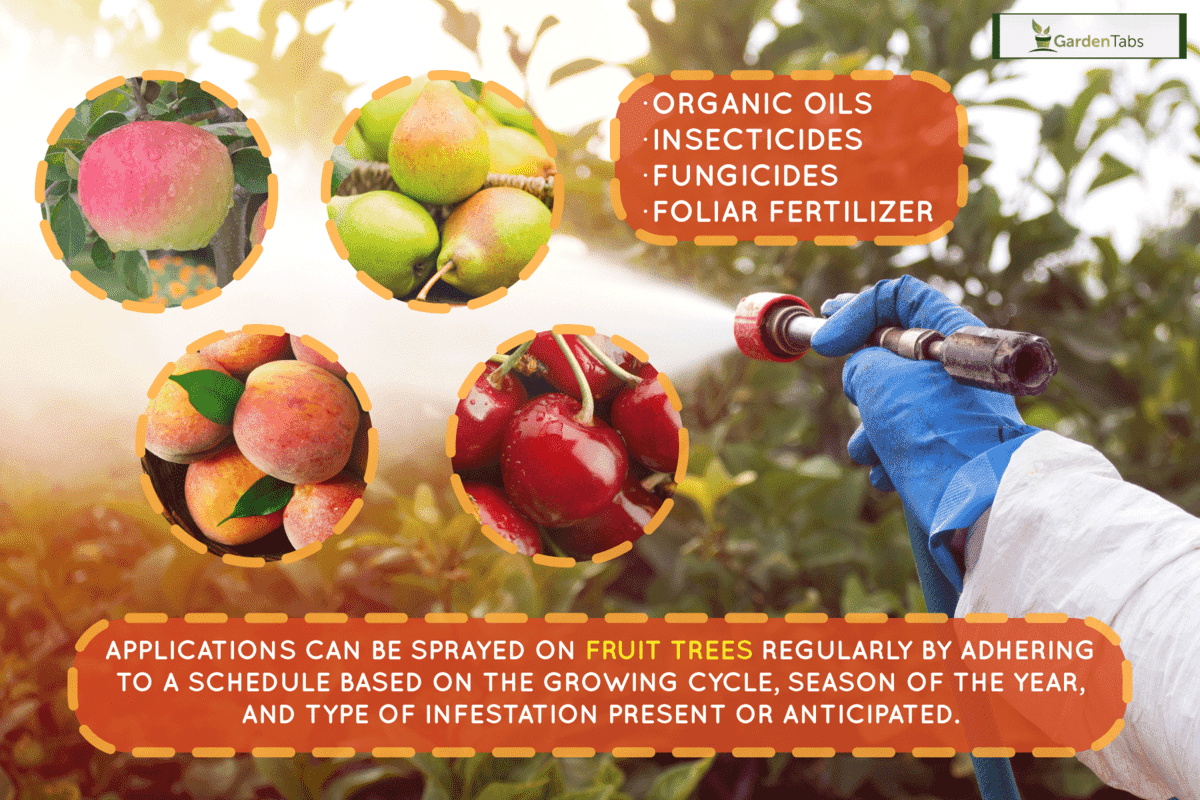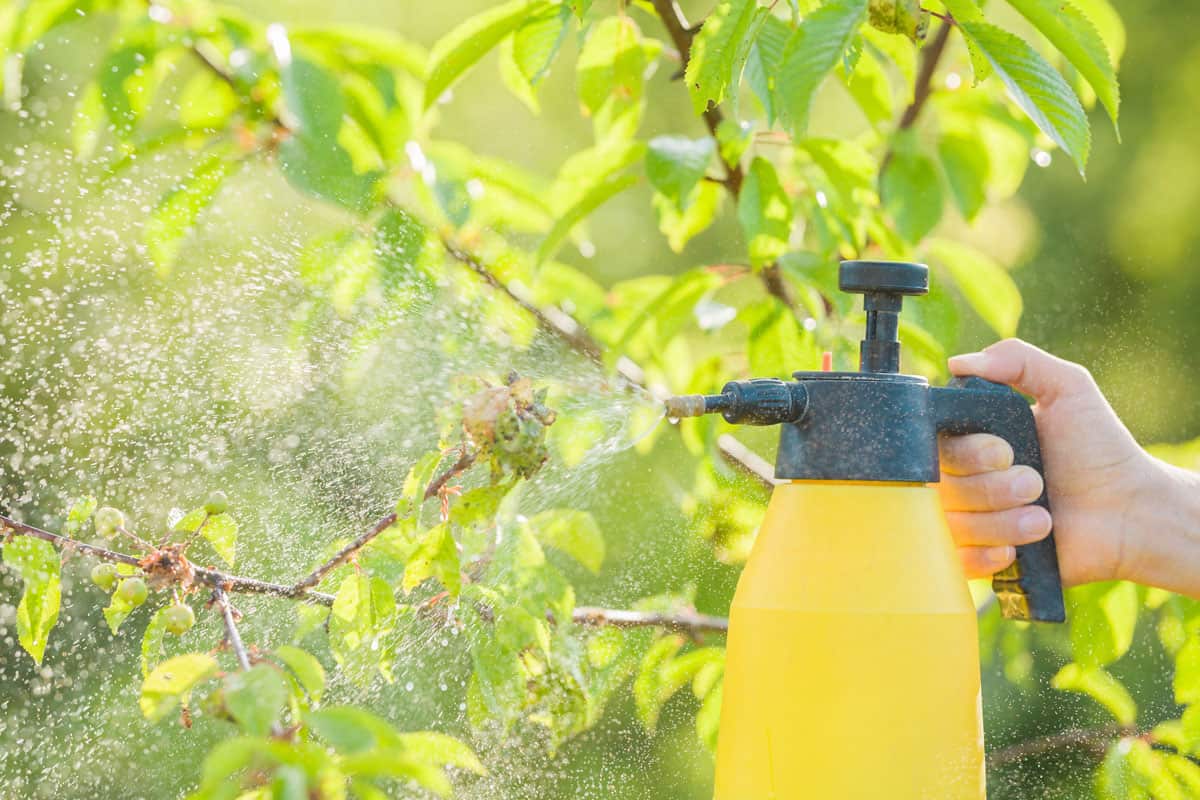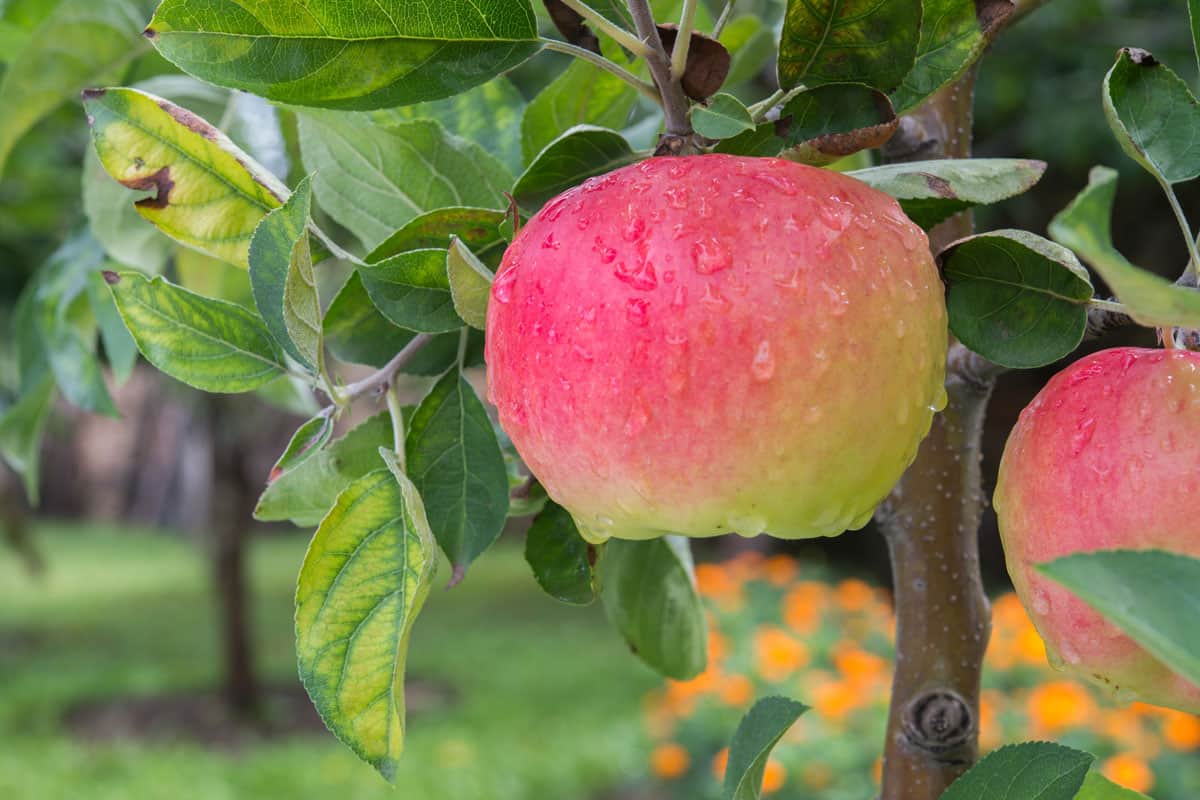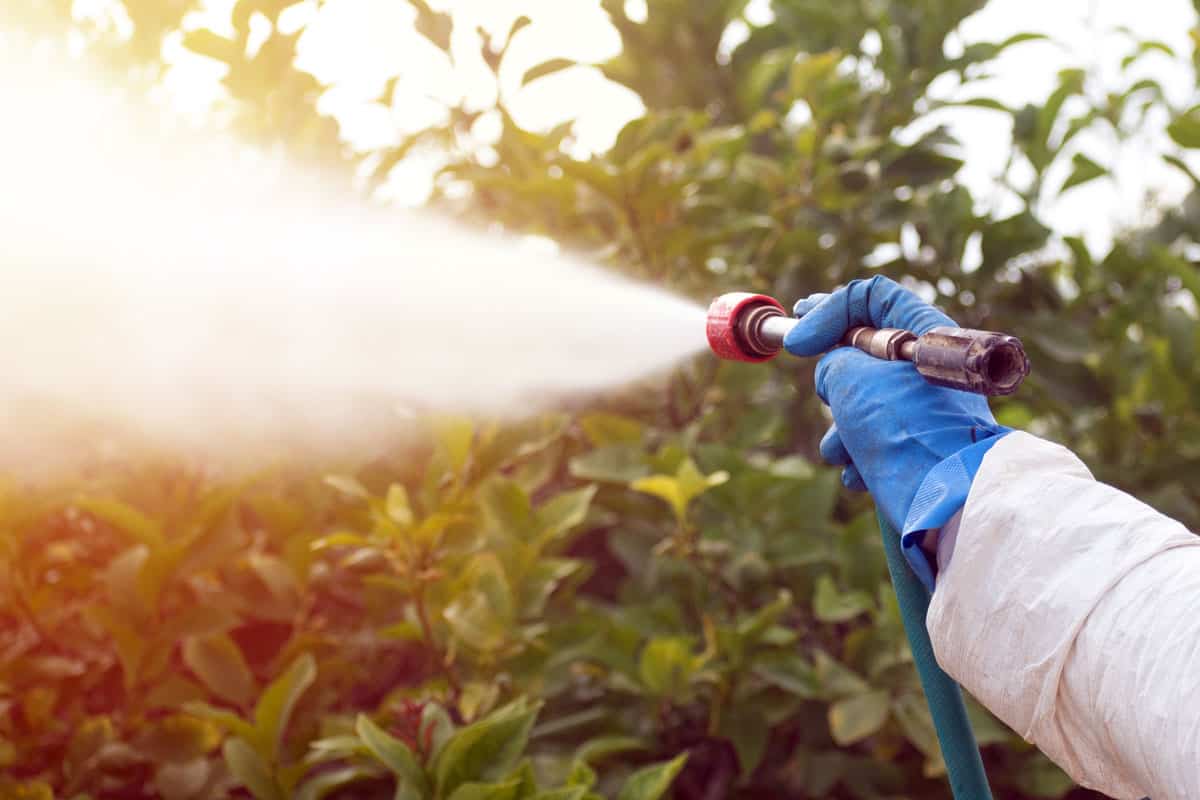Like most plants, fruit trees have their own set of needs in order to grow, thrive, and develop. Applying chemicals is a measure that ensures their overall health against pests and diseases. We have researched when and what to spray on fruit trees to help you prevent infestation and maintain a good, steady yield.
Organic oils, insecticides, fungicides, foliar fertilizer, and other applications can be sprayed on fruit trees regularly by adhering to a schedule based on the growing cycle, season of the year, and type of infestation present or anticipated.
Spraying fruit trees is considerably important. Various application methods need to be timely applied in order for the chemical to properly work. In this article, we aim to guide you with the ways on how to properly introduce the chemical to your trees.

Fruit Tree Spraying Schedule
Growth Cycle
Apply various sprays on a schedule relative to fruit trees' growth cycle to optimize their effectiveness and avoid interfering with or disrupting the plants' development. The stages of the process and their observable characteristics are as follows:
1. Dormancy
The dormant period refers to the inactive stage of the tree and usually coincides with winter. It is the stage just before the buds begin to swell in spring.
Dormant sprays are best used in late winter to control pests and diseases and need to be applied every three years.
2. Pre-blossom Stage
The pre-blossom stage features the formation or emergence of nodes that develop into bud clusters.
Insecticidal sprays are best applied during this stage since early budding attracts critters that feed on plant blossoms and developing tips. You might also use alternate treatments with different active ingredients to avoid insecticide tolerance.
3. Blossom/Bloom
The flowers begin to open and blossom for certain periods depending on the type and variety of fruit trees. Avoid any type of chemical application at this time since it may harm beneficial insects like bees or butterflies that facilitate pollination.
4. Petal Fall
Petal fall signifies the end of the blooming stage and the beginning of fruit production. It is a critical period since young produce are susceptible to bug, worm, and insect attacks.
General purpose fruit sprays work well to control infestation without affecting the growth cycle. They are, however, non-specific and may not be effective for all parasitic diseases.
5. Fruit Formation/Fruit Set
The final growth cycle stage concludes with fruit production that ends in the harvest. Mineral elements are necessary to supplement the content, structure, and overall yield quality.
Apply foliar fertilizer sprays to aid fruit development and provide nutrients lacking or absent in the soil.
Season And Climate
The prevalence of plant parasites is greatly influenced by the pervading climate. Warm or hot weather encourages the development of various tree diseases such as apple scabs, fire blight, and mildew rots. To prevent infection, you may have to apply fruit tree sprays regularly.
Sprays Used For Fruit Trees

General Purpose
General purpose sprays are intended to address all possible pest and disease conditions with a single application employing different ingredients to control and prevent plant infection.
Inasmuch as they are effective with most fruit trees, the relative strength and potency of most compounds cannot deter the presence of certain parasites. They may be used anytime during the growing cycle since the formulation is comparatively dilute.
General purpose sprays are meant for maintenance use for fruit trees that exhibit no considerable infestation.
Dormant Sprays
Dormant sprays with oil-based active compounds are effective against overwintering organisms that coincide with the trees' inactive period and become destructive in the spring.
They are generally applied in anticipation of parasites that exhibit advanced activity and damage before the pre-blossom and blooming stages of development. Dormant sprays do not need to be applied yearly if other pest control substances are used.
Fungicides
Fungicidal sprays prevent the spread of mold, mushrooms, and other forms of diseases associated with the parasite. Different fruit trees, however, vary in terms of vulnerability and susceptibility to specific pathogens that affect, disrupt, and prevent their full growth and potential yield.
It is important to note the actual fungi species since not all infections warrant the use of chemicals.
Insecticides
The application of insecticidal sprays is not seasonal but rather situational because you should only deal with the diseases and insects that are present.
Knowing the specific kind of pest is relevant to prevent further infestation. Insecticides should never be applied during the blooming stage since they may repel or kill beneficial pollinators.
Foliar Fertilizers
Foliar fertilizers are meant and function to augment plant development by being directly applied to leaves and foliage. It considerably boosts your tree's overall health, increases fruit productivity, and improves yield quality.
Apply foliar spray just before the petal fall stage. Remember that this type of spray cannot fully replace nutrients present in the soil. Apart from this, the tree cannot fully receive major elements needed for growth and development with only its leaves.
When To Spray Fruit Trees Based On Location
California
The period in which you will apply your fruit spray entirely depends on the type you are using. For instance, you should apply traditional dormant spray before the start of the winter season.
Since California has a warmer climate, dormant sprays are most likely applied in late November. You should stop applying during the blooming period. In this state, dormancy typically occurs in February or March.
New York
Since the winter months in New York begin in mid-December and last until March, you can start applying dormant oils in late March or early April. General sprays are used throughout the growing seasons, typically beginning in the early spring and lasting till summer.
Florida
Winter months in Florida have the mildest temperatures as compared to states in the Northern regions. Since the climate is moderately humid, pest infestations are more prevalent.
Insecticides and fungicides are ideally applied more frequently throughout the growing seasons. During April and May, it should be sprayed as often as 10 days. Copper fungicides may harm the fruit, especially when applied during hot weather. It is best to use Abound, Amistar Top, or Pristine as alternatives during the months of May to July.
Texas
Similar to Florida, pesticides and fungicides should be applied more regularly throughout the growing seasons because the climate is relatively warmer than most states.
Importance And Purpose Of Spraying Fruit Trees

The main purpose of spraying fruit trees is to control and prevent pest and fungal infestations. During the flowering and fruiting season, trees generally attract insects such as caterpillars, leafminers, worms, and other larvae. These can considerably damage the tree's overall growth and yield.
Leaf Spots
Leaf spots in trees are basically caused by fungi that overwinter from the previous season. The initial signs appear as yellowish discoloration on leaves that spread and darken as the disease progresses.
Fire Blight
Fire blight is a disease that considerably affects the flowers, shoots, and branches of trees. The leaves will appear burnt or scorched and will eventually wither and bend downward.
It is important to immediately trim or cut the stem of infected leaves to prevent the disease from spreading.
Gray Mold
Gray mold appears when there is poor air circulation or when the general environment is humid. It causes fruit damage that generally affects production and yield. Application of fruit tree sprays before, during, and after the blooming season is essential to treat the disease.
Application Tips For Specific Fruit Trees
Apples
The main reason why you need to spray apple trees is to prevent insects from doing considerable damage to the fruits. Spraying apple trees should be accomplished at the end of the blooming period and just before the harvesting season.
Cherries
Cherry trees need ample amounts spray during the dormant and growing seasons to prevent the proliferation of pests and diseases. Do not forget to familiarize yourself with the existing insects that may affect your cherry tree. Doing so will help you with finding the specific treatments.
Peaches
Applying horticultural dormant oil before buds start to swell is essential to get rid of overwintering pests such as mealybugs, mites, and aphids.
During this stage, you should also apply a good amount of fungicide - once when buds start to appear and a second one after 10 to 14 days.
After blooming or once petals have withered and dropped, use copper fungicide to prevent the proliferation of pests and diseases. Wait until almost all of the flowers have died back before application to avoid harming pollinators.
Regular pest control in the summer is essential to prevent potential fruits from withering and browning. Use Spinosad to remove spotted winged drosophila that causes these issues.
Lastly, it is necessary to apply copper-based fungicide during fall because it prevents various fungal diseases such as leaf curl, shot hole, and canker.
Pears
Pear trees need to be sprayed with dormant oil during spring to get rid of overwintering pests. Apply the substance thoroughly to properly eradicate these insects. After a few days or when the chemical has dried, use antibacterial sprays and a fungicide. This lowers the proliferation or spread of fire blight.
What Can I Use Instead Of Insecticide?
Boric acid is a more natural way to control infestation without introducing harmful chemicals that can affect pollinators and even humans. Dissolve the substance (1/2 teaspoon) into a gallon of water, then spray the mixture onto the tree's foliage.
In Closing

Apart from selecting the appropriate chemical agent, the proper application timing will result in better pest and disease control. You should consider the plant's stage of development, the general climate, and the season as well. We hope this article proved to be helpful.
